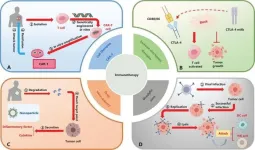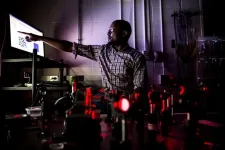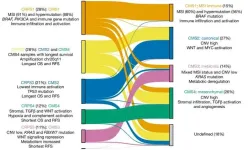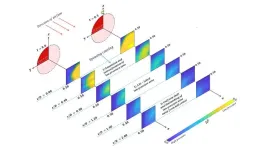(Press-News.org) Tailoring light with Nanomaterials
Metamaterials, engineered at the nanoscale, exhibit unique properties not found in naturally occurring materials. These properties arise from their nanoscale building blocks, which, until now, have been challenging to observe directly due to their size being smaller than the wavelength of light. The team's research overcomes this limitation by employing a new microscopy technique that can simultaneously reveal both the nano and macro structures of these materials.
A New Window into the Nano World
The key finding of this research is a methodological breakthrough that enables the visualization of structures previously too small to be seen with traditional microscopy. By using light in innovative ways, the scientists have discovered how to "trap" one color of light within the structure, and use a mixing with a second color that can leave the structure to visualize this trapped light. This trick reveals the hidden world of nanoscale optical metamaterials.
Over Five Years of Development
This achievement is the result of more than five years of dedicated research and development, utilizing the unique features of the Free Electron Laser (FEL) at the Fritz Haber Institute. This type of microscopy is particularly special because it allows for a deeper understanding of metasurfaces, paving the way for advancements in technologies such as lens design, with the ultimate goal of creating flatter, more efficient optical devices.
The Future of Flat Optics
By enhancing our understanding of metasurfaces, this research opens the door to the development of novel light sources and the design of coherent thermal light sources. „We are just at the beginning," states the research team, „but the implications of our work for the field of flat optics and beyond are immense. Our technique not only allows us to see the complete performance of these nanostructures but also to improve upon them, shrinking 3D optics down to 2D, and making everything smaller and flatter."
Metamaterials, engineered at the nanoscale, exhibit unique properties not found in naturally occurring materials. These properties arise from their nanoscale building blocks, which, until now, have been challenging to observe directly due to their size being smaller than the wavelength of light. The team's research overcomes this limitation by employing a new microscopy technique that can simultaneously reveal both the nano and macro structures of these materials.
A New Window into the Nano World
The key finding of this research is a methodological breakthrough that enables the visualization of structures previously too small to be seen with traditional microscopy. By using light in innovative ways, the scientists have discovered how to "trap" one color of light within the structure, and use a mixing with a second color that can leave the structure to visualize this trapped light. This trick reveals the hidden world of nanoscale optical metamaterials.
Over Five Years of Development
This achievement is the result of more than five years of dedicated research and development, utilizing the unique features of the Free Electron Laser (FEL) at the Fritz Haber Institute. This type of microscopy is particularly special because it allows for a deeper understanding of metasurfaces, paving the way for advancements in technologies such as lens design, with the ultimate goal of creating flatter, more efficient optical devices.
The Future of Flat Optics
By enhancing our understanding of metasurfaces, this research opens the door to the development of novel light sources and the design of coherent thermal light sources. „We are just at the beginning," states the research team, „but the implications of our work for the field of flat optics and beyond are immense. Our technique not only allows us to see the complete performance of these nanostructures but also to improve upon them, shrinking 3D optics down to 2D, and making everything smaller and flatter."
Metamaterials, engineered at the nanoscale, exhibit unique properties not found in naturally occurring materials. These properties arise from their nanoscale building blocks, which, until now, have been challenging to observe directly due to their size being smaller than the wavelength of light. The team's research overcomes this limitation by employing a new microscopy technique that can simultaneously reveal both the nano and macro structures of these materials.
A New Window into the Nano World
The key finding of this research is a methodological breakthrough that enables the visualization of structures previously too small to be seen with traditional microscopy. By using light in innovative ways, the scientists have discovered how to "trap" one color of light within the structure, and use a mixing with a second color that can leave the structure to visualize this trapped light. This trick reveals the hidden world of nanoscale optical metamaterials.
Over Five Years of Development
This achievement is the result of more than five years of dedicated research and development, utilizing the unique features of the Free Electron Laser (FEL) at the Fritz Haber Institute. This type of microscopy is particularly special because it allows for a deeper understanding of metasurfaces, paving the way for advancements in technologies such as lens design, with the ultimate goal of creating flatter, more efficient optical devices.
The Future of Flat Optics
By enhancing our understanding of metasurfaces, this research opens the door to the development of novel light sources and the design of coherent thermal light sources. „We are just at the beginning," states the research team, „but the implications of our work for the field of flat optics and beyond are immense. Our technique not only allows us to see the complete performance of these nanostructures but also to improve upon them, shrinking 3D optics down to 2D, and making everything smaller and flatter."
END
Breakthrough in nanotechnology: Viewing the invisible with advanced microscopy
2024-08-13
ELSE PRESS RELEASES FROM THIS DATE:
Tackling cancer from the inside out: A deep dive into immune checkpoint inhibitors
2024-08-13
In the past two decades, immune checkpoint inhibitors (ICIs) have revolutionized cancer treatment, showing promising results against various solid tumors. This study reviews recent developments in ICIs, focusing on new targets like T cell immunoreceptor with Ig and ITIM domains (TIGIT), T cell immunoglobulin and mucin domain-containing protein 3 (TIM-3), and lymphocyte activation gene-3 (LAG-3). These targets aim to overcome resistance mechanisms limiting the effectiveness of current therapies, such as anti-PD-1 and anti-CTLA-4. By identifying and developing these new ...
RPI Physicist Moussa N’Gom is using light to enhance nuclear security
2024-08-13
Our nation’s security depends on the effective detection of nuclear materials at our borders and beyond. To address this challenge, Rensselaer Polytechnic Institute (RPI) physicist Moussa N’Gom, Ph.D., is leading research aimed at developing a quantum sensing probe to detect and characterize special nuclear materials precisely and without contact. Special nuclear materials are only mildly radioactive but can be used in nuclear explosives.
The research is being conducted through RPI’s participation in the Consortium ...
The atmosphere in the room can affect strategic decision-making, study finds
2024-08-13
The atmosphere within a group can influence the outcome of strategic decision-making, according to a new study co-authored by Bayes Business School (formerly Cass).
Paula Jarzabkowski, Professor of Strategic Management at Bayes, along with researchers from University of Queensland, Macquarie University and Leuphana University of Lüneburg, found that different atmospheres led to people speaking and interacting in different ways that changed how they made sense of the strategy.
For instance, when the atmosphere was pensive, people were cautious about the way to proceed, whereas, when it was curious they felt ...
Study uncovers mutated driver genes in colorectal cancer: 9 novel to CRC and 24 previously undetected in any cancer
2024-08-13
The Institute of Intelligent Medical Research (IIMR) of BGI Genomics, in collaboration with Sweden’s Uppsala University, has published the largest multi-omics study of colorectal cancer (CRC) to date. The study aimed to understand the functional and prognostic impact of cancer-causing somatic mutations, revealing new genetic alterations and developing a new molecular classifier of tumor variants. This research was published in the journal Nature on August 7th, 2024.
Unveiling New Genetic Landscapes
The researchers analyzed the whole genomes and transcriptomes ...
Cricket physics: Science behind the modern bowler technique tricking batters
2024-08-13
WASHINGTON, Aug. 13, 2024 – Key to winning a cricket match is tricking the other team’s batters – no small feat as bowlers bowl cricket balls nearly 100 miles per hour. In recent years, a bowling technique that has become popular involves keeping the arm almost entirely horizontal during delivery, notably used by Sri Lankan stars Lasith Malinga and Matheesha Pathirana. The aerodynamics of such deliveries have perplexed sports physicists.
In Physics of Fluids, by AIP Publishing, researchers have started to unravel the mysteries of how ...
Measuring Martian winds with sound
2024-08-13
WASHINGTON, Aug. 13, 2024 – Mars has a notoriously inhospitable environment, with temperatures that fluctuate dramatically over the course of a Martian day and average minus 80 degrees Fahrenheit. Its surface is mostly covered in red dust, with terrain typified by craters, canyons, and volcanoes. And its atmosphere is extremely thin, comprising only about 1% of the density of Earth’s.
Needless to say, measuring wind speeds on the red planet is challenging. Martian landers have been able capture measurements — some gauging the cooling rate of heated materials ...
Posttraumatic stress disorder and type 2 diabetes outcomes in veterans
2024-08-13
About The Study: The findings of this cohort study of patients with comorbid posttraumatic stress disorder (PTSD) and type 2 diabetes suggest that PTSD is a modifiable risk factor associated with a modest reduction in microvascular complications. Further research is needed to determine whether findings are similar in non-Veterans Health Administration health care settings.
Corresponding Author: To contact the corresponding author, Jeffrey F. Scherrer, PhD, email jeffrey.scherrer@health.slu.edu.
To access the embargoed study: Visit our For The Media website at this link https://media.jamanetwork.com/
(doi:10.1001/jamanetworkopen.2024.27569)
Editor’s ...
Smartwatch measures of outdoor exposure and nearsightedness in children
2024-08-13
About The Study: In this 1-year prospective cohort study of children with smartwatches, continuous outdoor exposure with at least 15 minutes accompanied with no less than 2,000 lux sunlight intensity was associated with less myopic shift. These findings suggest that future outdoor interventions should focus not only on the overall time outdoors but also on the effective outdoor exposure patterns, as a means to effectively prevent myopia (nearsightedness) in children.
Corresponding Authors: To ...
Lurie Children’s Hospital awarded $12 million by PCORI to study best approach to treat mild pneumonia in young children
2024-08-13
Ann & Robert H. Lurie Children’s Hospital of Chicago, in partnership with University of Utah Health, has been approved for $12 million in research funding by the Patient-Centered Outcomes Research Institute (PCORI) for a study that will compare two ways to use antibiotics in young children with mild pneumonia, one of the leading reasons children seek acute care, who are well enough to be cared for at home.
The first approach is to prescribe and give antibiotics immediately, which is the current standard of care. The second way is to prescribe an antibiotic but not give it unless the child’s symptoms worsen or ...
PCORI announces $165 million in funding for new health research
2024-08-13
PCORI announces $165 million in funding for new health research
Approved awards support patient-centered comparative clinical effectiveness research (CER) on telehealth interventions, heart care and various health concerns
Aug. 13, 2024
WASHINGTON, D.C. – The Patient-Centered Outcomes Research Institute (PCORI) today announced the approval of funding awards totaling more than $165 million for new patient-centered comparative clinical effectiveness research (CER), as well as research to improve methods and strengthen the science of engagement in patient-centered CER. Among the 10 CER studies awarded, three will evaluate the effectiveness of telehealth interventions ...






